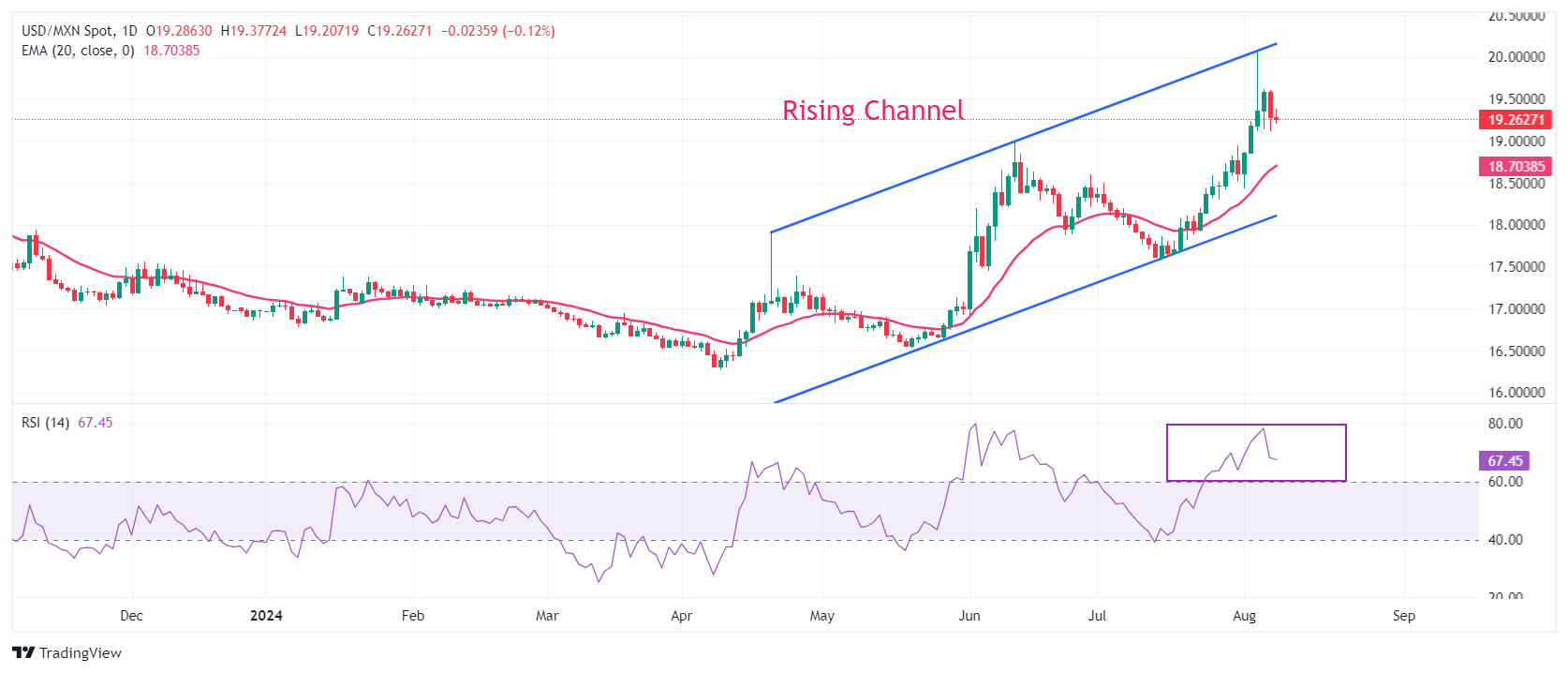- USD/MXN trades back and forth above 19.00 despite the volatile US Dollar.
- The Fed is expected to bring down interest rates aggressively.
- USD/MXN trades inside the Rising Channel chart pattern.
The USD/MXN pair trades in a limited range above the crucial support of 19.00 in Thursday’s European session. The asset consolidates from the last three trading sessions despite the US Dollar (USD) exhibiting sheer volatility.
The US Dollar Index (DXY), which tracks the Greenback’s value against six major currencies, corrects to near 103.00 on firm speculation that the Federal Reserve (Fed) will pivot to policy-normalization aggressively. 10-year US Treasury yields tumble to near 3.90%.
Meanwhile, investors await the United States (US) Initial Jobless Claims data for the week ending August 2, which will be published at 12:30 GMT. Investors will keenly focus on the weekly jobless claims as it is the only data available that will provide some cues about the current status of the labor market.
On the Mexican Peso front, the Mexican currency will be influenced by the spectre of controversial reforms to Mexico's constitution set for votes next month, including a potential judicial overhaul that would subject judges to popular vote, Reuters reported.
USD/MXN trades in a Rising Channel formation on a daily timeframe in which each pullback is considered a buying opportunity by market participants. The asset appears to be in a strong uptrend as the 20-day Exponential Moving Average (EMA) near 18.70 slopes higher.
The 14-day Relative Strength Index (RSI) oscillates in the 60.00-80.00 range, suggesting a strong upside momentum.
Fresh upside would appear if the asset breaks above August 6 high of 19.61, which will drive the asset towards fresh annual high near $20, followed by almost two-year high of 20.50.
On the contrary, a downside move below the crucial support of 19.00 would expose the asset to a 20-day EMA near 18.70 and July 5 high at 18.00.
USD/MXN daily chart
Mexican Peso FAQs
The Mexican Peso (MXN) is the most traded currency among its Latin American peers. Its value is broadly determined by the performance of the Mexican economy, the country’s central bank’s policy, the amount of foreign investment in the country and even the levels of remittances sent by Mexicans who live abroad, particularly in the United States. Geopolitical trends can also move MXN: for example, the process of nearshoring – or the decision by some firms to relocate manufacturing capacity and supply chains closer to their home countries – is also seen as a catalyst for the Mexican currency as the country is considered a key manufacturing hub in the American continent. Another catalyst for MXN is Oil prices as Mexico is a key exporter of the commodity.
The main objective of Mexico’s central bank, also known as Banxico, is to maintain inflation at low and stable levels (at or close to its target of 3%, the midpoint in a tolerance band of between 2% and 4%). To this end, the bank sets an appropriate level of interest rates. When inflation is too high, Banxico will attempt to tame it by raising interest rates, making it more expensive for households and businesses to borrow money, thus cooling demand and the overall economy. Higher interest rates are generally positive for the Mexican Peso (MXN) as they lead to higher yields, making the country a more attractive place for investors. On the contrary, lower interest rates tend to weaken MXN.
Macroeconomic data releases are key to assess the state of the economy and can have an impact on the Mexican Peso (MXN) valuation. A strong Mexican economy, based on high economic growth, low unemployment and high confidence is good for MXN. Not only does it attract more foreign investment but it may encourage the Bank of Mexico (Banxico) to increase interest rates, particularly if this strength comes together with elevated inflation. However, if economic data is weak, MXN is likely to depreciate.
As an emerging-market currency, the Mexican Peso (MXN) tends to strive during risk-on periods, or when investors perceive that broader market risks are low and thus are eager to engage with investments that carry a higher risk. Conversely, MXN tends to weaken at times of market turbulence or economic uncertainty as investors tend to sell higher-risk assets and flee to the more-stable safe havens.
Information on these pages contains forward-looking statements that involve risks and uncertainties. Markets and instruments profiled on this page are for informational purposes only and should not in any way come across as a recommendation to buy or sell in these assets. You should do your own thorough research before making any investment decisions. FXStreet does not in any way guarantee that this information is free from mistakes, errors, or material misstatements. It also does not guarantee that this information is of a timely nature. Investing in Open Markets involves a great deal of risk, including the loss of all or a portion of your investment, as well as emotional distress. All risks, losses and costs associated with investing, including total loss of principal, are your responsibility. The views and opinions expressed in this article are those of the authors and do not necessarily reflect the official policy or position of FXStreet nor its advertisers. The author will not be held responsible for information that is found at the end of links posted on this page.
If not otherwise explicitly mentioned in the body of the article, at the time of writing, the author has no position in any stock mentioned in this article and no business relationship with any company mentioned. The author has not received compensation for writing this article, other than from FXStreet.
FXStreet and the author do not provide personalized recommendations. The author makes no representations as to the accuracy, completeness, or suitability of this information. FXStreet and the author will not be liable for any errors, omissions or any losses, injuries or damages arising from this information and its display or use. Errors and omissions excepted.
The author and FXStreet are not registered investment advisors and nothing in this article is intended to be investment advice.
Recommended content
Editors’ Picks

AUD/USD jumps back above 0.6150 despite US-China trade tensions
AUD/USD has picked up fresh bids and regained 0.6150 in Thursday's Asian trading, resuming the previous recovery led by US President Trump's decision for an immediate 90-day tariff pause for many countries. However, escalating US-China trade war and Chinese disinflation could limit the Aussie's upswimg.

USD/JPY tumbles below 147.00, awaits US CPI for fresh impetus
USD/JPY has come under intense selling presure and drops below 147.00 in the Asian session on Thursday. The US-China trade war escalation and the divergent BoJ-Fed policy expectations underpin the Japanese Yen and weigh heavily on the pair amid a renewed US Dollar downtick. US CPI awaited.

Gold price awaits US CPI inflation amid deepening US-China trade war
Gold price is biding time near $3.100 in Asian trading session on Thursday, gathering strength for the next push higher. The further upside in the Gold price depends on the upcoming US Consumer Price Index (CPI) data.

Dogecoin soars as 21Shares files S-1 for DOGE ETF
Dogecoin rallied nearly 12% on Wednesday after asset manager 21Shares filed an S-1 application with the Securities & Exchange Commission to launch the 21Shares Dogecoin exchange-traded fund.

Tariff rollercoaster continues as China slapped with 104% levies
The reaction in currencies has not been as predictable. The clear winners so far remain the safe-haven Japanese yen and Swiss franc, no surprises there, while the euro has also emerged as a quasi-safe-haven given its high liquid status.

The Best brokers to trade EUR/USD
SPONSORED Discover the top brokers for trading EUR/USD in 2025. Our list features brokers with competitive spreads, fast execution, and powerful platforms. Whether you're a beginner or an expert, find the right partner to navigate the dynamic Forex market.




